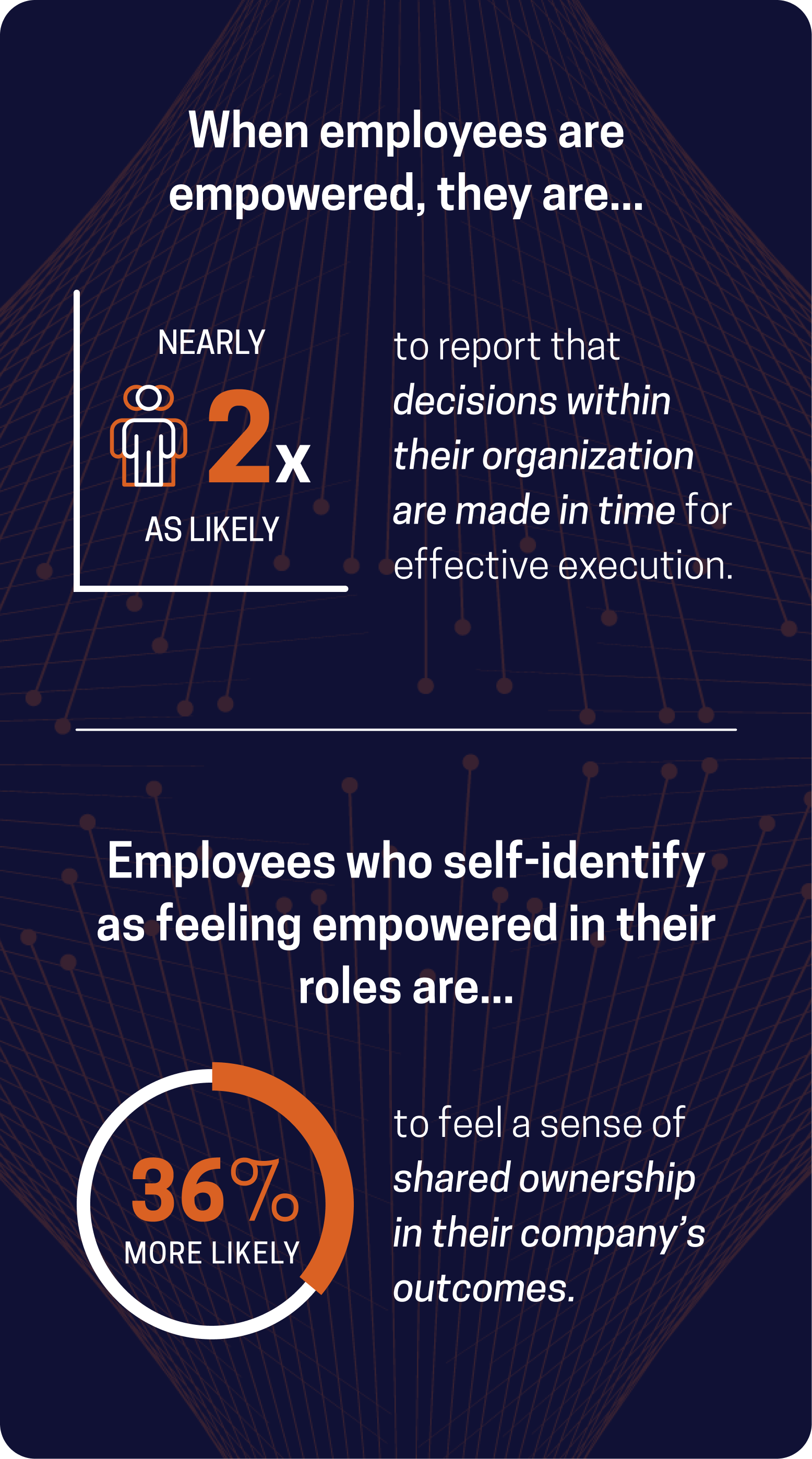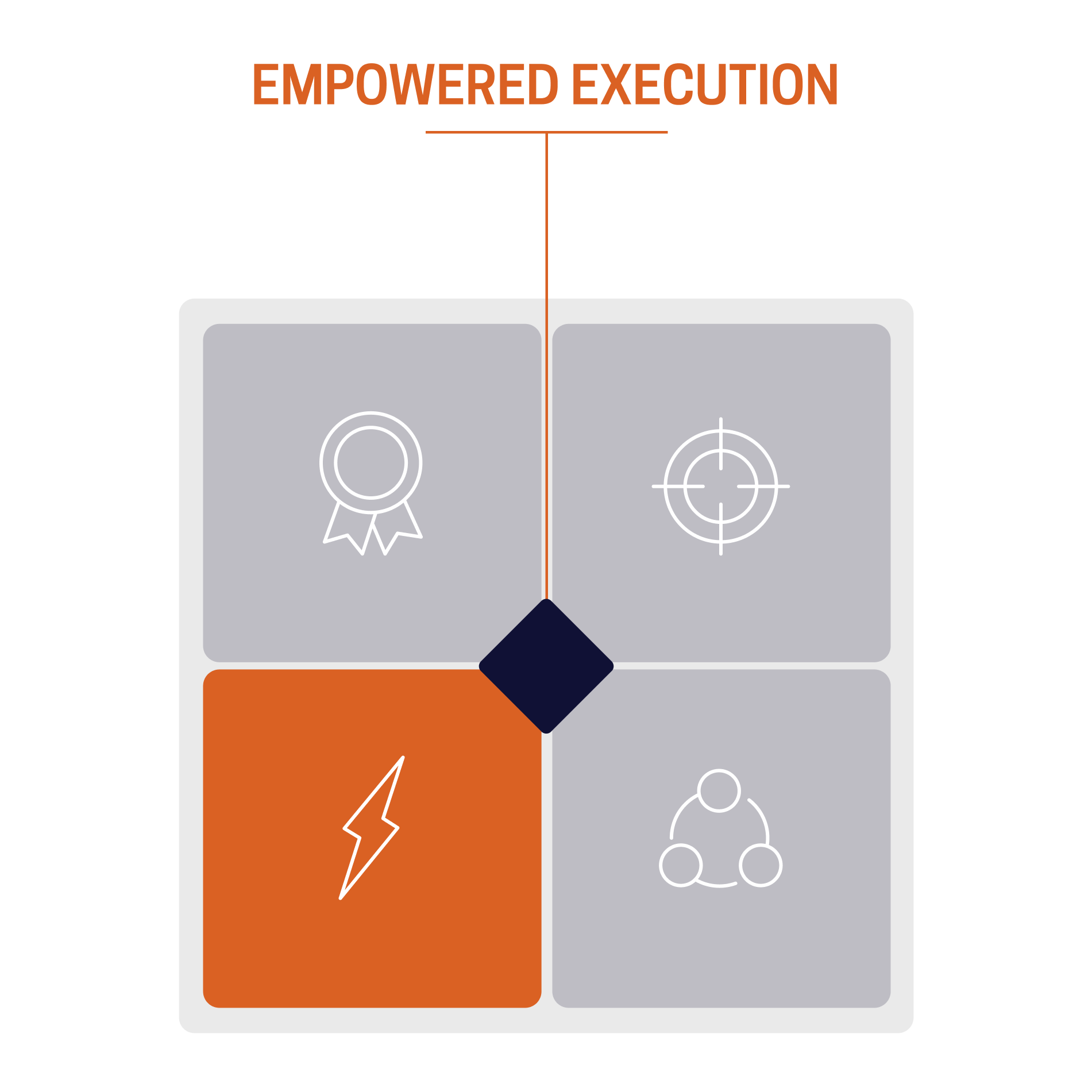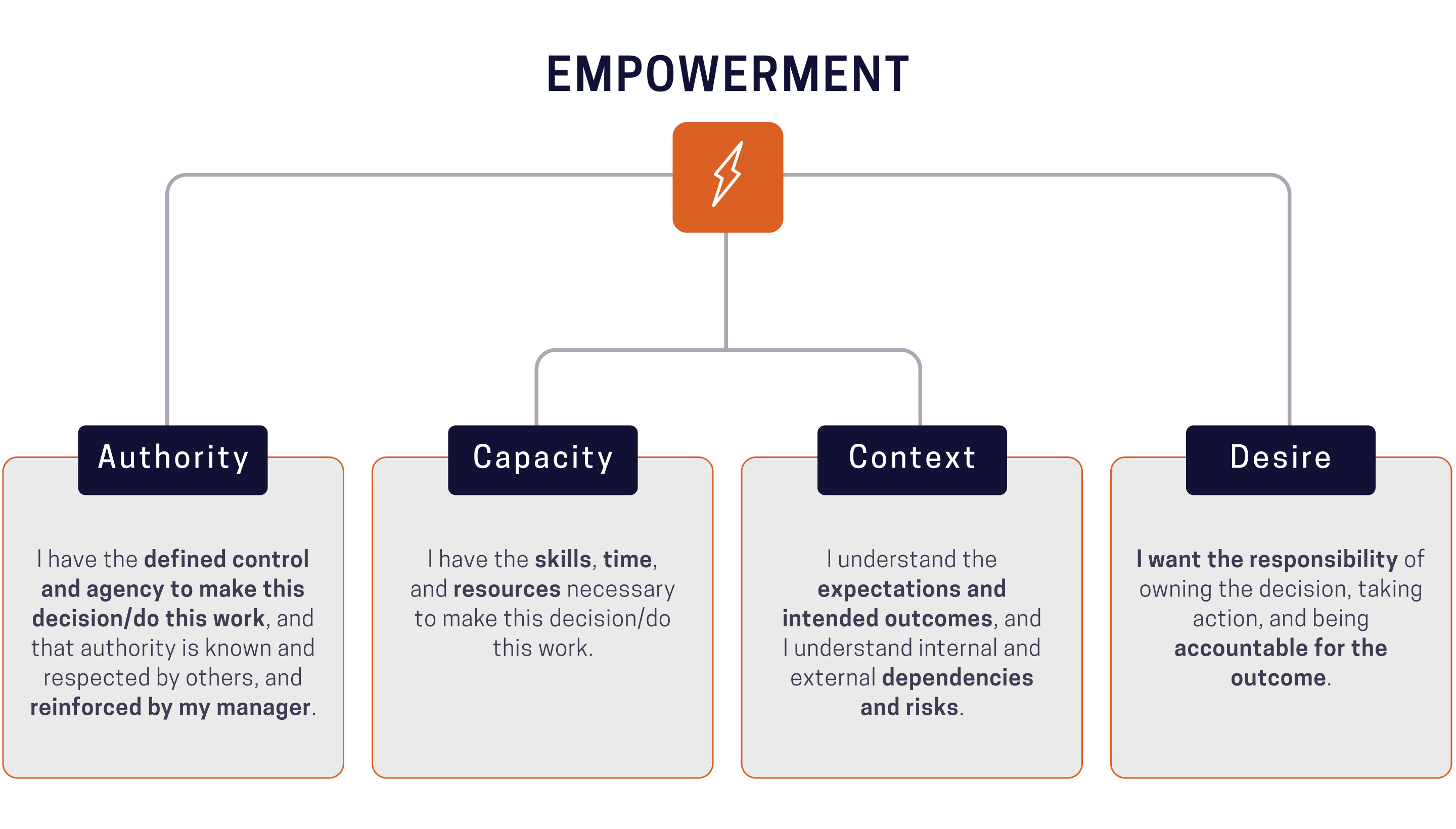Empowerment. It’s a word often spoken in leadership circles and celebrated as essential to organizational effectiveness. However, here’s the truth: it seems simple in principle, but it's incredibly challenging in practice. Many leaders fall into the trap of declaring, “You are empowered!” without offering the structure, clarity, or environment that allows true empowerment to flourish.
The question isn’t whether empowerment is valuable. That’s a given. The real question is how leaders can intentionally create the confines where empowerment drives results.
Empowered execution is about more than granting autonomy. It’s about decentralizing decision-making to ensure your teams can adapt, innovate, and outperform at the speed your environment demands. And the numbers don’t lie:

- When employees are empowered, they are nearly twice as likely to report that decisions within their organization are made in time for effective execution (McChrystal Group, 2025)
- Employees who self-identify as feeling empowered in their roles are 36% more likely to feel a sense of shared ownership in their company’s outcomes (McChrystal Group, 2025)
- Organizations with high employee empowerment see 26% higher revenue per employee (Gartner, 2018)
- Empowered teams are 3.5 times more likely to be innovative (McKinsey, 2021)
- Organizations with empowered employees have 50% lower turnover rates (Harvard Business Review, 2018)

Empowered execution is the linchpin of the Team of Teams® Framework, sitting as the fourth and final step. But true empowerment cannot exist in isolation. It relies on the foundational elements of Trust, Common Purpose, and Shared Consciousness to have power and longevity. Without these pillars, empowerment remains a hollow concept.
Once these capabilities are strong, how do leaders move from theory to execution? How do they build a culture where teams feel empowered to act decisively, innovate freely, and own the outcomes of their work? How do they become empowered to empower?
The answer lies in mastering the Four Essential Elements of Empowerment:
- Authority: Empowerment only works when leaders push decision-making down to the levels that intersect most closely with the challenge. Are you granting teams the authority they need to act?
- Capacity: Authority without capability is a quick road to frustration and resentment. Have you equipped teams with the skills, tools, and resources necessary to succeed?
- Context: Teams can’t act effectively without understanding the broader strategy. Do they see how their decisions align with the organization’s mission and goals?
- Desire: Lastly, empowerment requires motivation. Are your teams inspired and incentivized to take ownership and perform at their best?
Leadership is more than just delegating tasks. It’s about creating the conditions where autonomy drives action and action delivers impact.

How Leaders Can Empower Their Team
Many equate empowerment with authority. However, in our work with hundreds of organizations and thousands of leaders, McChrystal Group found this authority-only view of empowerment allows for more decentralized decision making, but it does not ensure effective decentralized decision making.
When leaders delegate authority without ensuring their team has the necessary context to understand the big picture or the desire to be accountable for the outcome, they often spend their time course-correcting or making decisions that their team was authorized to make.
Effective leaders don’t just relinquish control; they actively cultivate empowered teams by evaluating and investing in the core drivers of empowerment.
1. Authority Without Clarity Breeds Confusion
True authority isn’t just the power to act; it's the ability to inspire others to act. It’s the confidence that comes from unambiguous decision rights, which defines what decisions must be made, who holds accountability, and how these decisions will be executed. When leaders fail to clarify decision rights, teams stall, unsure of their ability to act without approval. However, true empowerment comes when these decision rights are reinforced at every level.
Authority in Action
Imagine Sabine, a manager who delegates a customer conflict resolution to her team member, Tim. Despite her clear intent, Sabine’s peer keeps pulling Sabine back into the discussion, slowing down Tim’s efforts and impacting the expedited resolution of the customer’s issue. To correct this, Sabine schedules a direct conversation with her peer to explain Tim’s mandate, as he is in communication with the customer and has the experience to make the right decision. Sabine asks questions to understand why she needs to be involved in addition to Tim. After confirming her requested involvement was unrelated to any negative experiences, Sabine asks for her peer’s partnership in reinforcing her delegation of this matter to Tim.
Leader Tips:
- Assess Barriers to Decentralized Decision-Making: Identify internal systems, processes or rules that prevent your team from accomplishing the delegated task and remove those barriers to accelerate execution.
- Clarify Decision Rights: Discuss decision space with your team to ensure everyone knows where their authority begins and ends. Remember, that while a leader can delegate authority, they can never delegate responsibility.
- Establish Decision Guardrails: Use simple rules to establish clear and consistent guardrails to create confident decision making.
2. Capacity: The Foundation of Competence
Authority without capacity is a false promise. Empowerment falters when the team lacks the skills, experience, time, and resources to execute effectively. A leader who hands off authority without building capacity sets the team up for frustration, not success. Without the ability to accomplish the task at hand, both the leader and the team member question the competence of the other. Competence is an essential component of trust.
Leaders are less likely to empower their teammates if they do not trust their competencies to perform the job well. Similarly, employees are less likely to feel empowered if they have not received adequate time and resources to get the job done. McChrystal Group found that across 75,000 responses spanning all industries and organizational levels, employees who “always receive sufficient lead-time to accomplish important projects” had 61% higher empowerment scores compared to employees without adequate lead-time.
Capacity in Action
Bill needs to conduct market analysis for his executive team. Although he is familiar with the tools and systems required for the analysis, he faces difficulties in completing the project within the deadline. Susan, one of Bill's teammates, volunteers to assist him with the report. However, Bill fails to communicate his expectations, does not demonstrate the analytic systems, and neglects to allocate time for Susan to learn the systems independently. As a result, Susan spends valuable time, energy, and resources but still misses the deadline, falling short of meeting Bill's expectations. A small investment of time and pertinent questions regarding competency could have enabled Bill to avoid this situation, develop a colleague to take on the responsibility, and build trust. Unfortunately, Bill's lack of initial capacity investment led to resentment between him and Susan.
Leader Tips for Building Capacity:
- Grow Your Team’s Skills: Set up targeted coaching to develop a specific skill, broker a mentorship for them, or facilitate formal training opportunities. These small investments energize your team and create increased capacity.
- Prioritize Efforts: Prioritize activities and decisions based on the resources available. Prioritizing effectively almost immediately increases empowerment because employees know where to focus their energy and time, making them more effective. Read more about effective prioritization strategies here.
- Obtain Resources: Ensure the resources necessary to execute are available before delegating accountability. Focus on the essential tasks that align with team goals and reduce distractions. While some ideas may seem exciting, there’s often a good reason why they’re not resourced. Understanding these reasons helps leaders and employees focus their energy on what’s most critical and impactful.
3. Context: Ensure Your Team Understands the Big Picture
True empowerment starts with clarity. When every team member understands how their actions contribute to the broader mission, the entire organization operates with purpose, alignment and impact. Drawing from the proven Team of Teams® Framework, providing strategic context is more than just sharing goals; it’s about equipping your team to make empowered decisions in real time.
When leaders articulate how individual performance aligns with organizational objectives, they unlock Common Purpose and Shared Consciousness. This creates a shared understanding that not only elevates performance but also drives smarter decision-making. According to McChrystal Group data, employees who strongly agree their leaders connect individual goals to team objectives achieve 60% higher empowered execution scores than those who don’t see the connection. Strategic clarity isn’t just an operational tool; it’s a leadership necessity that accelerates outcomes, mitigates risks, and improves overall collaboration.
Just as important is understanding how current activities, priorities, and decision tradeoffs impact the organization. Employees who feel informed about how other teams’ activities, priorities, and decisions affect their work report a 36% increase in empowered execution. When teammates fail to see the ripple effects of their actions on others’ timelines and deliverables, the entire system becomes vulnerable to inefficiency and failure.
Context in Action
Maria is juggling multiple priorities: tight deadlines for reports, an impending performance appraisal, and a critical project nearing its breaking point. Faced with impossible demands, she takes decisive action, informing her supervisor, Tanya, that she’s strategically shifting her focus to the project and appraisal. Why? Because Tanya, from the very beginning, established clarity. She communicated the project's strategic value, aligning it with the organization’s overarching objectives, and labeled it a top priority.
Leader Tips:
- Communicate the Vision: Regularly connect individual roles and tasks to broader organizational objectives. Offer regular feedback that connects individual performance to team and organizational goals. Team members should understand how their work aligns with the overall mission.
- Share Insights on Stakeholder Priorities: Offer context about the expectations, priorities, and concerns of key stakeholders, allowing employees to meet immediate needs and manage broader relationships with long-term implications.
- Foster Cross-Team Collaboration: Encourage open communication and collaboration between different teams. Regular inter-team meetings create a shared understanding of priorities and challenges, ensuring awareness of how their work impacts others and helps make informed decisions.
4. Ignite Desire in Your Team
Empowered teams don’t happen by accident; they’re intentionally built by leaders who understand what drives human motivation. Empowerment starts with creating an environment where your team feels safe to take responsible risks, solve problems, and make decisions without fear of retribution. If your employees are hesitant to act decisively, it may signal that your environment lacks trust or tolerance for inevitable failures. The best leaders understand that failure is not only a possibility in complex environments; it’s inevitable, and it can be valuable.
Empowering teammates is about accelerating decision-making and developing the team, not testing them. True empowerment isn’t performative. It’s not about giving permission while secretly pulling strings. It’s about transferring meaningful authority to your team, enabling them to own decisions and shape outcomes. Micromanagement can suffocate innovation, erode trust and psychological safety, and delay critical progress. Real empowerment accelerates decision-making while cultivating development and accountability.
Desire in Action
Mark invited Lena to lead a software launch, promising her full ownership. Lena created a plan, received approval from Mark to move forward, and began executing. However, Mark frequently criticized her decisions around stakeholder management, introduced new success criteria and priorities mid-project, and raised hypothetical risks during team meetings that weren’t part of the original scope. Mark asked to review each communication to key stakeholders, but without the necessary time, Mark often took weeks to share feedback. Lena became frustrated and disengaged, losing confidence and trust in Mark. The launch was delayed, and both felt disappointed with the outcome.
Leader Tips:
- Identify Acceptable Risks: Be honest with yourself about the type of risks you are comfortable with and use decision guardrails to make those boundaries clear to your team. Identify specific areas where employees can take ownership and reinforce their authority to make decisions in those spaces.
- Reward Risk-Taking: Shift the narrative around mistakes. When your team takes ownership or makes bold decisions, call it out publicly. Recognize effort and intent, whether the outcome succeeds or fails. Visibility and positive reinforcement validate their contributions and strengthen their accountability while building a learning culture across the team.
- Encourage Solution-Centric Thinking: Empower your team to shape the path forward. Invite them to define problems, propose solutions, and execute initiatives. Provide strategic guidance but resist the urge to micromanage their processes. When teams are trusted to drive meaningful actions, it deepens their sense of ownership and sharpens their decision-making skills. Empowerment is not about testing competency; it’s about growing it.
Transform Your Leadership Mindset
Empowering your team requires a shift in perspective from commanding tasks to enabling ownership. Build a culture where accountability and confidence intersect, creating a team ready to own decisions, tackle challenges, and drive outcomes.
The question isn’t whether your team can take on more responsibility; it’s whether you’re ready to empower them to do so. Are you setting the stage for your team to rise, or are you holding onto reins that hinder their growth? Ownership starts with leaders who are bold enough to pass the torch.
Step into the role of an empowering leader. Real growth happens when teams know their contributions matter and their efforts are valued.
Are you looking to grow your leaders and empower your people?



